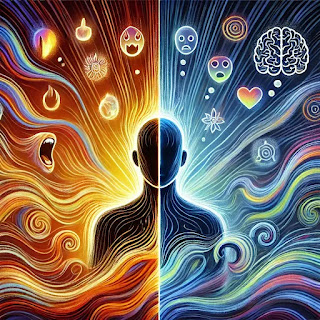Understanding the Difference Between Emotions and Feelings
 |
| "Emotions are the raw, instinctive reactions; feelings are the stories we tell ourselves about those emotions.'' |
In our daily lives, we often use the terms emotions and feelings interchangeably. However, these two concepts, while closely related, are distinct in their nature and function. Understanding the difference between them can help us better navigate our inner world and improve our emotional intelligence. Let’s dive into what sets emotions and feelings apart.
What Are Emotions?
Emotions are raw, instinctive, and universal reactions to stimuli. They are hardwired into our biology and are often considered the body’s first response to a situation. Emotions are:
Automatic and Immediate: Emotions arise quickly, often before we even have time to think. For example, if you hear a loud noise, you might feel fear instantly.
Physiological: Emotions are tied to physical reactions, such as a racing heart, sweating, or tears.
Universal: Basic emotions like joy, anger, sadness, fear, surprise, and disgust are experienced by people across cultures.
Short-Lived: Emotions tend to be fleeting, lasting only as long as the triggering event.
For example, if you see a snake, your immediate emotional response might be fear, accompanied by a surge of adrenaline.
What Are Feelings?
Feelings, on the other hand, are the mental associations and reactions we have to emotions. They are more subjective and personal, shaped by our thoughts, experiences, and beliefs. Feelings are:
Processed and Reflective: Unlike emotions, feelings involve cognitive processing. They are the stories we tell ourselves about our emotions.
Psychological: Feelings are more about our mental state than our physical state.
Individual: While emotions are universal, feelings vary from person to person based on their unique perspectives and experiences.
Longer-Lasting: Feelings can persist long after the initial emotional reaction has faded.
For example, after the initial fear of seeing a snake (emotion), you might feel anxious or uneasy (feeling) as you reflect on the experience.
Why Does This Distinction Matter?
Understanding the difference between emotions and feelings can help us:
Improve Emotional Regulation: By recognizing that emotions are automatic, we can learn to respond to them more mindfully rather than reacting impulsively.
Enhance Self-Awareness: Identifying our feelings helps us understand how we interpret and process our emotions, leading to greater self-awareness.
Build Better Relationships: When we understand our own emotions and feelings, we can better empathize with others and communicate effectively.
Foster Emotional Intelligence: Distinguishing between the two is a key step in developing emotional intelligence, which is crucial for personal and professional growth.
Practical Example: A Day at Work
Imagine you receive critical feedback from your boss. Your immediate emotional response might be anger or frustration (emotion). However, as you reflect on the feedback, you might feel discouraged or motivated to improve (feeling). Recognizing this distinction allows you to process the feedback constructively rather than reacting defensively.
Conclusion
Emotions and feelings are two sides of the same coin, but they play different roles in our lives. Emotions are the raw, instinctive reactions that arise in response to stimuli, while feelings are the personal, reflective interpretations of those emotions. By understanding and distinguishing between the two, we can better navigate our inner world, improve our relationships, and grow emotionally.
Next time you experience a strong emotion, take a moment to pause and reflect: What is the underlying feeling? How can you respond in a way that aligns with your values and goals? This simple practice can transform the way you experience life.


good
ReplyDeletePost a Comment
Thank you for your feedback. Stay with us.